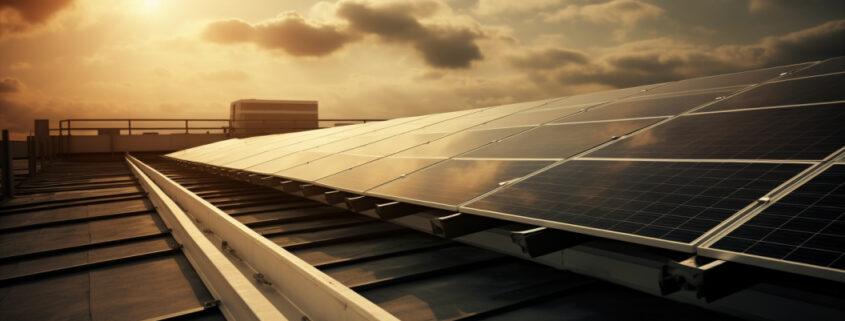Has the rise in energy costs hurt your bottom line? As energy bills keep rising, it may be time to consider commercial solar panels. But can solar panels take care of all your business’s energy needs? How much energy does a commercial solar panel produce?
The amount of energy your system can produce depends on what type of solar panel system you have and how big your system is. That may sound complicated but don’t worry. We’ll break it all down so you can figure out the potential power output you could get from switching to renewable energy.
How Do Solar Panels Work?
Solar panels are made up of photovoltaic cells. A solar energy system converts sunlight into electricity through a process called photovoltaic effect. When direct sunlight hits a solar PV system, the photons excite electrons in the material, creating electricity when the electrons move. An inverter changes the electricity into direct current (DC) energy.
Common Types of Solar Panels
There are a few common types of solar PV systems. The three most popular models are monocrystalline, polycrystalline, and thin-film. They have some key differences, such as the amount of electricity they produce and the cost to install them.
Polycrystalline
Polycrystalline is made from multiple crystal structures. To make the crystals, silicon is melted and poured into a mold. These panels typically come with a bluish tint. They have lower efficiency than monocrystalline and need a larger solar array to generate the same amount of power.
Monocrystalline
Monocrystalline solar panels are made from a single crystal structure that produces a consistent black color. They have higher efficiency ratings than polycrystalline panels and can better withstand higher temperatures. The upfront cost of monocrystalline panels is more than that of polycrystalline but advances in solar technology have decreased the cost difference in recent years.
Thin-Film Solar Panels
Thin-film solar panels have a lower efficiency than both polycrystalline and monocrystalline panels. However, the material is extremely flexible, making it ideal for applications where more rigid panels won’t work, such as curved or irregular surfaces.
Typical Commercial Solar Panel Output
The amount of clean energy a solar panel produces is measured in kilowatt-hours (kWh). A single monocrystalline panel typically produces 320 watts to 380 watts or 2 kWh of electricity per day. A polycrystalline panel can produce 250 watts to 300 watts or 1.5 kWh per day, and thin-film panels usually produce less than 200 watts.
The higher the number of panels in your system, the more electricity you will produce (that’s if you have the roof space to support them). Keep in mind that these results come from standard test conditions, and several factors affect the watt-hours your panel produces.
What Affects Solar Panel Efficiency?
Not all solar panel systems produce the optimal watts of power. Many issues could lower your solar panel system’s efficiency and lifespan. If you notice your solar cells producing a lower-than-average wattage, a few common culprits could be to blame.
Improper Solar Panel Installation
The angle and tilt of your solar array affect energy production. If your solar panels aren’t positioned to take in as much direct sunlight as possible, it could lower their energy output. Hire reliable and knowledgeable contractors if you want high-efficiency solar panels.
Local Climate
No matter what, solar panels in areas that get more hours of sunlight perform better than those installed in areas with a lot of cloud coverage. Additionally, colder climates have been shown to increase energy efficiency, whereas hot temperatures may decrease your system’s power output.
Dust and Dirt
Your solar panels need to be able to take in a high amount of sunlight in order to produce energy. If dust or debris coats the surface of your solar panels, it could reduce their energy output. It’s important to keep your solar panels clean so they can operate the best they can.
Shade
If trees or other structures obstruct your system from getting direct sunlight, it will significantly impact energy production.
Can Solar Power Save You Money?
Since solar panel installation comes with a high upfront cost, you may be worried that the lower electricity bills still won’t provide a good return on your investment. However, if you are generating enough power to take care of your own energy needs and then some, you can actually make money from producing clean energy. Through a net metering program, you can receive compensation for the excess power your system generates.
Tax Credits and Incentives
There are a lot of ways you can cut down on the initial cost of solar panel installation. The Federal Investment Tax Credit (ITC) allows you to deduct a percentage of the cost of your solar panel system from your federal taxes. Depending on what state you live in, there are some other financial breaks and incentives offered to encourage clean energy usage.
Solar Panel Systems Made Easy
So how much energy does a commercial solar panel produce? As you can see, that varies depending on your commercial building’s location and the panels you choose to install. The best way to find out is to contact the experts. TEMA can provide you with all of the insight needed for solar panel installation and the optimal installation of your solar panel system. Want to see how low your electricity bills can go? Contact us today for a free consultation.





